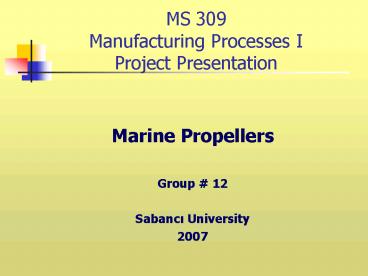MS 309 Manufacturing Processes I Project Presentation - PowerPoint PPT Presentation
1 / 14
Title:
MS 309 Manufacturing Processes I Project Presentation
Description:
Propellers are commonly used devices which transmits power by converting it into ... Commonly used for inboard props. Processes. Modelling ... – PowerPoint PPT presentation
Number of Views:186
Avg rating:3.0/5.0
Title: MS 309 Manufacturing Processes I Project Presentation
1
MS 309 Manufacturing Processes IProject
Presentation
- Marine Propellers
- Group 12
- Sabanci University
- 2007
2
Istanbul Dockyard Command Headquarters
- Production for the navy on a project shop basis
- Fourth biggest dockyard in Europe
- Marine propeller production for navy
3
Product Information
- Used in various ships, submarines
- Propellers are commonly used devices which
transmits power by converting it into thrust for
propulsion - Momentum or acceleration of the water results in
a force which we can call thrust. - Propellers are both pushing and being pulled
through the water
4
Common Parts
5
Design specifications
- Fatigue failure
- When the propeller is subjected to a
cycling loading for a long time, a structural
damage may occur on the surface of the material
even if the stress value is much less than the
ultimate tensile stress. - Smooth surfaces are needed to prevent this
phenomena and this problem is overcomed up to
some level by grinding method that makes the
propeller surface smoother.
6
Design specifications
- Cavitation
- A thermodynamic process occuring in the
inlet of the propeller due to the very high
speeds gained by water molecules. The pressure
decrease rapidly causing water molecules to
vaporize and damage the blades.
7
Design specifications
8
Design specifications
- Static-Dynamic balancing
- Cavitation tests
9
Common Parts
- Leading Edge Part of the bladewhich first cuts
the water. - Trailing Edge Part of the blade which water
leaves through. - Blade Root Part that blade and hub connects.
- Hub The metal surface that generally transmits
the propeller thrust through the forward thrust
hub.
10
Raw Material
- Aliminium Basic standard material. Light weight
and strength. Easy machining. - Stainless Steel For high performance and
strength. 24-10 SST Alloy. - Bronze/Nibral Nibral means nickel and used for
hardness. Commonly used for inboard props.
11
Processes
- Modelling
- Casting CO2 sand casting, concrete sand casting,
arda casting and the regular sand casting - Finishing
- Grinding
- Static-Dynamic balancing
- Pitchometer tests
- Cavitation tests
12
Casting
- Istanbul Dockyard Command Headquarters use 4
types - of casting techniques. We will focus on Arda
Casting. - Propellers shape is created by using mills.
- First, centers are determined.
- Then, the mill is located toward the center. One
of the blades is completed by rotation technique.
While doing this the reference is the center that
was pre-determined. - Repeating this process, other blades are formed
continuously. - After all the blades are completed, a good
surface quality is maintained by further
operations.
13
Finished Product
14
REFERENCES
- Pictures from
- sites.mercurymarine.com/portal/page?_pageid126,48
572,126_49275_dadportal_schemaPORTAL - http//xahlee.org/Whirlwheel_dir/boat/propeller3.j
pg































